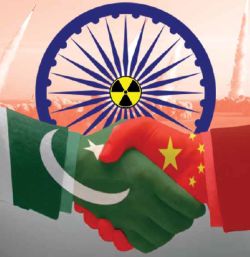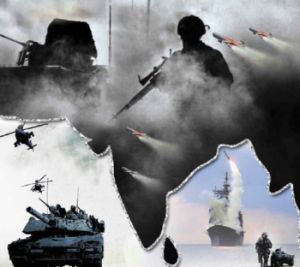An excellent civilian perspective on the aspect of Limited wars against a Nuclear backdrop. India is perhaps the only country that faces the challenges arising from having two nuclear neighbours, who closely cooperate with each others’ nuclear programmes and who maintain adversarial relations with her. A nuclear-weapon enabled terrorist threat is supported by strong and consistent denials of culpability for any such ‘non-state’ attack and a reliance on its ‘protector’ and mentor, China, to handle the inevitable diplomatic furore that is bound to rise if the taboo on nuclear weapons is broken with however limited an application. It would appear that Pakistan has adopted a policy of battlefield use of its nuclear weapons, a likely escalation of a conventional confrontation to a nuclear level, arrangements for rapid deployment which could entail pre-delegation to unit commanders in the event of a loss of communications, (which is what apparently happened at Salala recently when 24 Pakistani soldiers were killed in an ISAF air attack on two border posts). She asserts that there is a need to slightly tweak our nuclear doctrine; the objective would be not to change our No First Use policy, but to revert to the language of the Draft doctrine on the question of retaliatory strikes — these should be ‘punitive’ rather than ‘massive’ as now exists. Lastly, she makes the very bold assertion that in order to disillusion the adversary of our intent to retaliate, the control of the weapons should be placed squarely with the Strategic Forces Command.
This article is published with the kind permission of “Defence and Security Alert (DSA) Magazine” New Delhi-India
 |
Recent developments in India’s neighbourhood have led to an increase in the instability in the region with particular implications for India’s security. Pakistan’s foolhardiness — or as the Pakistanis view it, their boldness — in challenging the international community by deciding to not attend — and to not allow its surrogates, the Taliban — to attend the just concluded Bonn Conference on Afghanistan, in taking actions which could see a military confrontation with the US and the ISAF forces on its western border and when it is such a parlous situation at home, can only arise from their assurance that at least politically and diplomatically, if not militarily, they can depend on the support of China. Despite India’s own efforts to manage her prickly relations with China, such unqualified support of Pakistan, particularly in the military and nuclear areas, must inevitably raise concerns in India.
India is perhaps the only country that faces — or has ever faced — the challenges arising from having two nuclear neighbours, who closely cooperate with each others’ nuclear programmes and who maintain adversarial relations with her. To be sure, during the Cold War, the Soviet Union faced several hostile nuclear neighbours, which were bound together in an alliance and from 1971, another nuclear neighbour that formed a formidable challenge to its security. China, too, till 1971 and for about a decade before that, faced both the United States and the Soviet Union in adversarial positions. It was in the context of the Cold War that theories of limited conventional wars under a nuclear overhang — usually on different continents — has been developed by scholars, mainly in the West. Whether such theories are applicable to the dual challenge facing India is a question that needs to be carefully considered.
Unique scenario
The situation that India faces today is unique; firstly, it shares common and disputed borders with both hostile neighbours; China has, according to several knowledgeable commentators and intelligence sources (of the West) built-up Pakistan’s nuclear arsenal almost from scratch — providing designs, material, including fissile material, technology, delivery vehicles (either directly or through North Korea) and even conducted a weapons test in 1990 on its Lop Nor Test site, for Pakistan. Today it is supplying reactors, which it claims will be under IAEA safeguards; but given the short shrift it has given the Nuclear Suppliers’ Group, not to mention its obligations under the NPT in arriving at the agreement to do so, it is unlikely that the material from these reactors will remain for civilian purposes only. Thirdly and most dangerously, Pakistan has been using its growing nuclear arsenal as an umbrella under which it appears to feel that it can use sub-conventional attacks against India with little or no danger of (conventional) retaliation.
None of the above has been seriously disputed by either party; nor has the vague but ominous ‘red lines’ that Pakistan seems to have evolved regarding its stated doctrine of first use of nuclear weapons. It appears to have in mind the escalation of any conventional response from India to even an armed attack on Indian soil by its nationals, to a nuclear counter-response. The theories of deterrence would seem to not be applicable in a situation if there is a ‘failure of rationality’ on one side. Of course, it could very well be that the intention is to indeed give an impression of irrationality, to act as a deterrent to any action on India’s part for fear that Pakistan would react ‘irrationally’. This stand, of what has been termed ‘a nuclear-weapon enabled terrorist threat’ is supported by strong and consistent denials of culpability for any such ‘non-state’ attack and a reliance on its ‘protector’ and mentor, China, to handle the inevitable diplomatic furore that is bound to rise if the taboo on nuclear weapons is broken with however limited an application. India’s doctrine calls for ‘massive retaliation’ in the event of a nuclear first strike; that would entail attacking counter-value targets, which could include cities and other population centres. There would inevitably be calls for restraint on India’s part, despite the enormity of the action by Pakistan and there is also likely to be some domestic resistance to attacks on cities or towns. In this, perhaps, worst-case but not improbable, scenario, what are India’s options?
There are some facts which are needed to be factored in to any consideration of the issue.
Difference between a ‘declaratory’ doctrine and an operational one; the latter can only be deduced from the information available on acquisitions and capabilities, statements of policy by albeit retired senior military men from Pakistan and such Western sources, presumably from intelligence inputs. On the basis of these, it would appear that Pakistan has adopted a policy of battlefield use of its nuclear weapons, a likely escalation of a conventional confrontation to a nuclear level, arrangements for rapid deployment which could entail predelegation to unit commanders in the event of a loss of communications, (which is what apparently happened at Salala recently when 24 Pakistani soldiers were killed in an ISAF air attack on two border posts)
Sino-Pak nexus
Firstly, we need to take China’s support of Pakistan for granted, even the use by the latter of non-state groups as a part of their foreign and security policy. This has been demonstrated repeatedly and not only in the UN Security Council, where China has blocked any forward movement on the naming of specific Pakistani nationals and sponsored groups as terrorists. Secondly, while the state of the internal instability in Pakistan is probably exaggerated in the media, Indian, Pakistani and the Western, there is no doubt that there is a considerable rise in religiosity with strong sectarian and intolerant strains in Pakistani society in general; this would have an inevitable impact on all state institutions, including the military. At the same time, the military has not yet abjured its support for specific non-state groups as ‘assets’ in the furtherance of its foreign policy objectives. Some of the groups may well be out of control of the military, though there is little apparent effort to control them in any effective way, though some other groups, targeting the Pakistani state, are being attacked or negotiated with, according to press reports. Thirdly, while like many other developing countries, Pakistan’s economy is currently in a very fragile condition, the worsening of relations with the US may adversely affect the budgetary support that Pakistan has been used to receive — China usually restricts itself only to project and commodity aid and does not give budgetary support to any of its allies, however close. Notwithstanding these developments, the ambitions of Pakistan’s military remain vaulting. Given these facts, it is clear that the situation is such that in the event of any crisis, or with the intention of creating one, India could face nuclear threats at multiple levels from Pakistan — it is not unlikely that these would be supported by China, which, however, will ensure that it is not directly involved.

 von
von 

